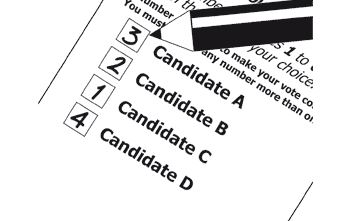Voter fatigue

The problem (or at least one of many) is voter fatigue. It is one thing to vote once for a candidate in an election, but if there are many candidates that means the chances for any one getting 50.1% of the vote is slim.
In our system, the top two leading candidates get another shot at winning with another election – the runoff.
So there’s the problem… voter fatigue. Here’s how to fix that, so that a single election always produces a 50.1% or better winner. I call it Cascading Voting. There are variations on this method, but I like this method the best, especially the “Secret Sauce.”
Let me give you an example…
There are six candidates, so the voting ballot will have check boxes for each of the six. Our current system allows the voter to select only one of the six. The problem is that it’s unlikely that any one will win outright as “dilution” is a problem.
Dilution is when there are so many candidates that the votes are spread too thinly for one to reach 50.1%. The odds decrease with the number of candidates. If there are two, one must reach 50.1%; if six, not likely.
From a practical perspective, I doubt that most voters really know who they vote for but rely on the words – Incumbent, Republican, Democrat or other identifier. They’ll cast their votes based on name or party recognition, usually because the candidate is in politics as a career, so people become familiar with the name. Or they just see lots of ads. and that name sticks with them for a little while, just long enough to cast their ballot.
So rather than each voter casting their vote for a single candidate, they actually cast six votes (in this example) based on preferential order. In other words, the voter has one candidate that they want to win. They get 1 against their name. They also like another candidate, but not as well as number one, so they mark 2 against their name and so on through number six… whom they detest.
As the ballots will be scrambled 720 possible ways, it won’t matter if some people vote 1 through 6 down the list or vice versa, as it won’t favor certain candidates depending on their last name. By scrambling, Adams won’t necessarily win by having a name beginning with A.
Without an outright winner, the person in last place is disqualified and those ballots votes from from 2 through 6 are redistributed, as they represent the voter preference in numerical order 2 through 6. So 2 through 6, become 1 through 5 for the purposes of the vote count. Then the count begins again.
As the counting is done with computers, the entire process is almost instantaneous.
If there’s not a clear winner, then the next person in last position is disqualified and the voters’ votes are redistributed (1 through 4) and so on until a candidate gets to 50.1%. That person wins.
In that way, the majority of the voters’ choice of preferred candidates will see their candidate elected. It’s a far better system than what we have now.
At the moment, under our current system if the “preferred candidate” does not get elected in the first round, it gives the dominant party a second chance to “get out the vote” so their candidate will win eventually. It usually works the way that the major party wants.
Now, here’s the Secret Sauce. Every race will have a “None Of The Above” checkbox. I suspect that this “candidate” will win many races, but it won’t be a factor in the Cascading Voting calculations. It will be only be used to let the winning candidate know that many voters (of the few who bother to vote) don’t support any of them. That means the winner needs to actually do a good job for the public, practicing public service, and not public (self) service.





